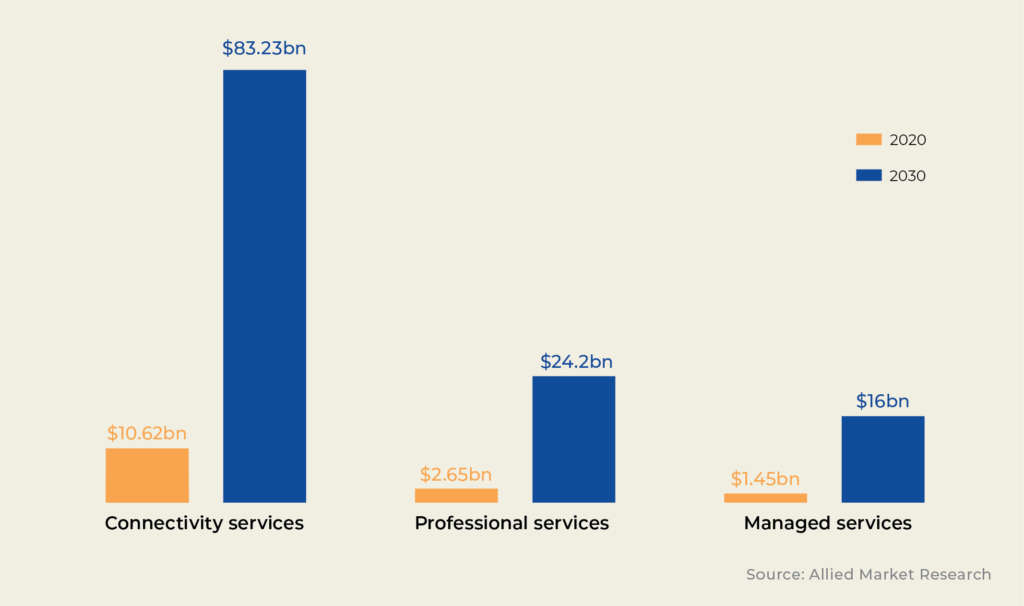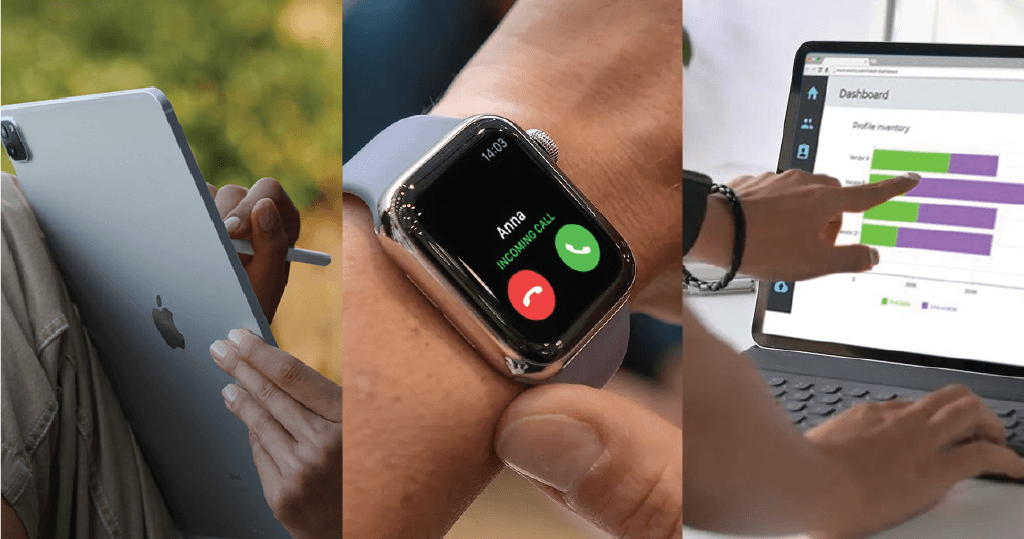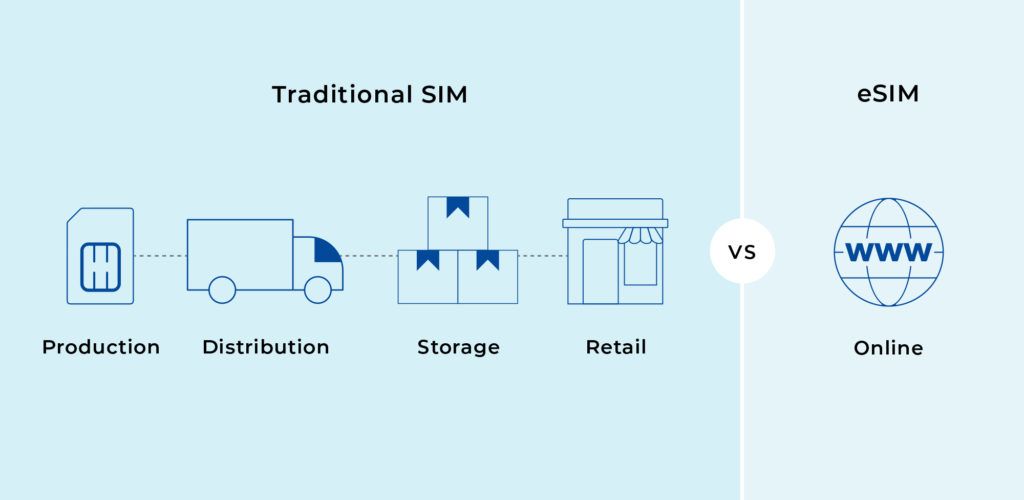A report by Facts and Factors says the embedded subscriber identity module or eSIM market was worth USD 8.9 billion in 2021. At a 16.42% compound annual growth rate from 2022 to 2028, the eSIM market is projected to grow to an impressive USD 25.8 billion by the end of the forecast period.
The increasing popularity of machine-to-machine SIM (M2M SIM) applications is one of the eSIM market’s growth factors and a key priority moving forward for mobile network operators (MNOs). Allied Market Research’s report on the global M2M market supports this. In that report, the cellular M2M market size was valued at USD 10.62 billion in 2020. It is expected to grow to USD 83.23 billion by 2030, with a 23.2% compound annual growth rate (CAGR).
M2M market growth

ESIM adoption in consumer electronics (smartphones, wearables, laptops, etc.) is another eSIM growth driver. The industry is optimistic the consumer electronics market share will continue to grow in the following years. One of the factors fuelling this market segment expansion is the increase in consumer electronics manufacturers integrating eSIM into their products.
In fact, according to Grand View Research, 27 eSIM smartphone models were launched in 2020 despite the pandemic. By December 2021, Global System for Mobile Communications (GSMA) Intelligence said there were 57 eSIM smartphones in the market, and 82 countries had eSIM service for smartphones.
These developments indicate that the eSIM market is growing and, sooner or later, it will overtake the traditional SIM market. Thus, for industry stakeholders, the question is not if they should switch to eSIM but when they must do it. After all, the advantages of switching to eSIM are also evident.
1. Enhance M2M services and activate revenue from high-value enterprise clients
eSIM to play a key role in M2M services

2. Increase average revenue per user through multi-SIM applications
According to a Yahoo! Finance article, the global smartwatch market is expected to grow to 230.30 million units by 2026. That’s a CAGR of 21.98% from 2021 until the end of the forecast period. This accelerated consumer adoption of wearables is an opportunity for MNOs.
The eSIM is a natural fit for wearables because of its small form factor. Offering eSIM services, therefore, will let MNOs expand their customer base to the (based on the data above, considerably large and expected to get bigger) wearables market.
Market potential of companion devices

Additionally, subscribers are expected to have multiple connected devices (nearly four per subscriber on average) by 2023. For subscribers, managing and maintaining a separate number and mobile plan for each device will be inconvenient.
With eSIM, subscribers can maintain and own as many devices as they want, but these devices can all have a single number. Thus, MNOs can create multi-SIM mobile plans to serve this need. They can also try to upsell single-SIM users to these multi-SIM plans.
3. Avoid supply chain problems
The COVID-19 pandemic demonstrated MNOs’ vulnerability to world supply chain fluctuations. When factories manufacturing SIM cards closed, companies providing SIM card packaging and collateral stopped operations, cargo companies charged sky-high prices, and MNOs suffered from SIM card supply shortages and inflated manufacturing and distribution costs.
The eSIM will prevent a repeat of this problem. With eSIM, MNOs will no longer have to manage the associated challenges of the manufacture and distribution of physical SIM cards.
4. Save on manufacturing and distribution costs
As newer devices will have the SIM embedded within the device itself by the original equipment maker (OEM), MNOs will no longer need to issue physical SIM cards themselves. This means they can eliminate the cost of SIM card manufacture and distribution. This includes actual manufacturing, packaging, transportation, storage, and retail costs. These elements represent a large proportion of a network operator’s supply chain.
eSIM cuts out manufacturing and distribution costs for telcos

By removing them, MNOs significantly reduce the outlay to sell subscriptions which enhances their margins and opens up greater opportunities, such as in the travel market where lower acquisition costs suddenly make short-term network users profitable. In addition to cost, there is a significant time saving by removing some very complex and geographical-dispersed operations. Of course, some may argue the real benefit here is the reduced impact on the environment and the enhanced sustainability for the network operator.
5. Expand market share
MNOs can expand their consumer offerings and penetrate the enterprise market with the help of eSIM technology.
As mentioned earlier, eSIM can help accelerate the growth of and is a great fit for consumer wearable tech. The industry is optimistic about eSIM’s widespread adoption not only in smart watches but also in remote health monitoring gadgets, fitness trackers, augmented and virtual reality headsets, and other smart, internet of things (IoT) devices that require a cellular network connection for remote operation and data transmission.
eSIM adoption: beyond the smartphone

Likewise, eSIM is a great fit for asset tracking, point-to-point communications in machine-to-machine (M2M) systems, and other enterprise applications.
MNOs can also implement creative customer acquisition strategies that will eat away at their competitors’ market share. The thing that scares some MNOs about eSIM — the easy switching between carriers that it affords customers — can be leveraged to an MNO’s benefit.
An MNO can devise unique service offerings that meet unmet market needs and win subscribers away from other operators. They can create ingenious mobile subscription plans that offer great value and an excellent customer experience. Such strategies can enlarge their market and increase their revenue.
Enabling eSIM benefits
The transition to eSIM is inevitable. Instead of fighting the trend, MNOs can adopt the technology earlier. This way, they will have mature systems in place by the time the M2M and consumer markets have fully transitioned to eSIM.
To take advantage of the eSIM switch, MNOs must have a reliable and flexible eSIM management platform.
Workz offers an end-to-end consumer and M2M/IoT eSIM solution — from eSIM manufacturing to connectivity and remote management. In particular, we provide an advanced open eSIM management platform that lets MNOs orchestrate eSIM subscriptions, whether M2M or consumer, from a common interface. With Workz’s Multi-tenant eSIM Hub (MeSH), MNOs can manage multiple tenants, vendors, sites, channels, and platforms using a single unified eSIM management solution.
Switch to eSIM. Contact us to learn about our eSIM manufacturing and subscription management services.


